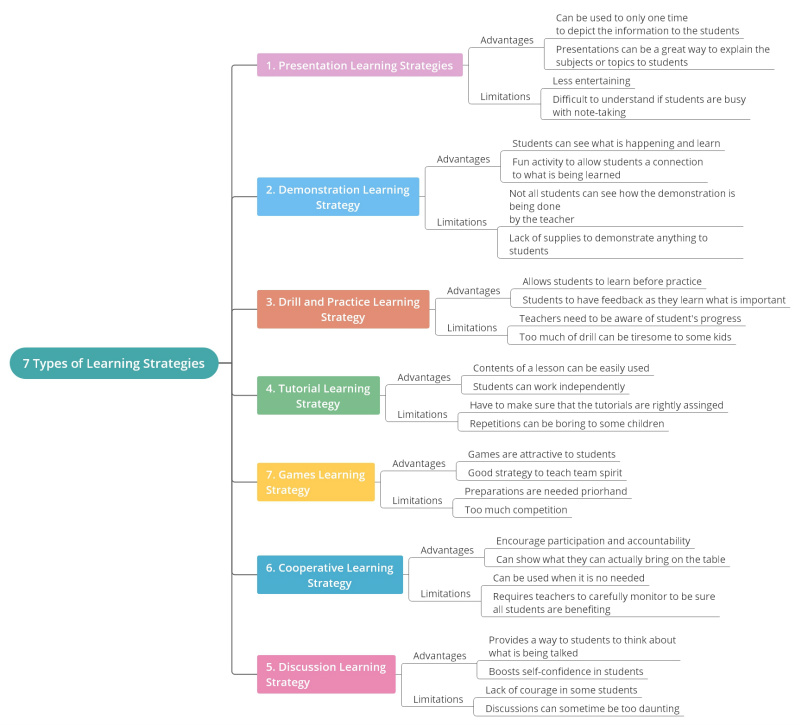How To Use Mind Map for Making Learning Strategies

Learning is based on the teaching process on how the students interpret their instruction. Educators spent a great deal of time focusing on these factors and developing ideas to strengthen them. Meaningful and holistic learning focuses on the fact that not all students learn the same way. Learning techniques can be subjective, and it is up to the instructor to ensure that they reach students at the maximum point of influence.
Variability in the forms of learning is a common occurrence. Understanding the variations between different ways of learning styles will have a significant effect on how teachers treat their pupils, set up community events, and mobilize around the learning process. The main objective of learning strategies is to make students more successful. Research on this topic has shown multiple ways of doing this.
This article will dive deep into the various types of learning strategies and look into how to create a learning strategy.
By knowing the difference between learning styles, teachers may end up with a couple of students lagging behind their classmates — in part because they haven't triggered their particular learning style.

Source: EdrawMind
- Presentation Learning Strategy
Using visual aids-visual elements will benefit most learners, and it will help them understand complicated topics by breaking them into simple visual imagery, providing visual analogies and metaphors.
Graphics are sometimes not easy to use for specific topics, but consider writing critical points in front of the class as this provides visual indications. It is a great way to explain the subjects or topics to students.
- Demonstration Learning Strategy
In this type of learning strategy, students can view what is happening and learn based on applied knowledge. Demonstration learning helps establish a connection between the student and the topic by ensuring that they are involved in the process.
- Drill ,amp; Practice learning strategy
In this type of learning strategy, students are allowed to learn before they practice. This helps in facilitating a connection between learning and the students. It helps improve their motivation to learn.
- Tutorial Learning Strategy
Contents of a lesson are used in this strategy. Tutorials are assigned to the students keeping in mind that repetition shall be avoided. Repetition can be monotonous. Students are then allowed to work independently and contribute back to other learning strategies making it useful.
- Discussion Learning Strategy
Discussions motivate students to listen actively to chosen speakers who follow a guiding lesson pattern and summarize previous points. Students organize and facilitate class discussions by alternating positions, selecting the following speaker regularly.
Students are positioned in a situation where they benefit from their peers’ thoughts, consciously, and engagingly generating new content considerations. This technique is beneficial for students because it facilitates excellent and direct involvement in courses.
- Cooperative Learning Strategy
Encourage students with different skills to work together through the introduction with small groups or courses. By expressing their thoughts and answering others, students gain self-confidence and strengthen their communication and critical thinking skills that are important for their lives.
The solution of mathematical puzzles, scientific experiments, and the production of short dramatic drawings are just some examples of how cooperative learning is integrated into the classroom.
- Game Learning Strategy
Game-specific learning platforms encourage students to collaborate with their teachers to achieve their learning goals and add depth and distinction to their educational experience.
This plan needs to be planned. Mathematical games and blogs are at the forefront of successful technical learning.
Step 1 Open EdrawMind on your desktop or laptop -,gt; Choose Mind Map and select a template.

Source: EdrawMind
Step 2 Add text and use the wide range of symbols from the libraries available to create your learning strategy mind map.

Source: EdrawMind
Step 3 Save and export your diagram to any file type you wish to. EdrawMind is compatible with multiple file types like Office, PDF, Evernote, and graphic files.

Source: EdrawMind
- Reciprocal Questioning
Use reciprocal questioning to foster an open dialogue in which students take on the teacher's role and create their questions about a subject, reading section, or lesson.
Divide the class into pairs or small groups after covering your chosen topic in class or after assigning a reading selection and have students come up with a few questions to discuss with the rest of the class.
- Three-Step Interviews
The three-step interview, a cooperative learning strategy, encourages students to develop active listening skills by questioning one another, sharing their thoughts, and taking notes. To use the interview process in three steps, divide students into - interviewer, interviewer, and notetaker.
- The Pause Procedure
Use the pause procedure to intersect strategic pauses into your classroom lectures and improve student comprehension of teaching material. To use the pause procedure, arrange two to three-minutes pauses in between every 10 to 15 minutes of reading time.
During these brief breaks, the students are encouraged to discuss or rework their notes in pairs to clarify key points covered, raise questions, and solve the instructor's problems.
Despite the conflicting evidence that different learning strategies are significant, it's good to know other teaching methods. By varying the teaching methods, teachers can retain their students’ attention longer and make the learning experience holistic. Mind maps are a great way to map out learning strategies. EdrawMind can be used to create these types of learning strategies, here’s why
- This easy-to-use, flexible mind mapping tool is designed to help you generate modern, fresh visuals. By combining the bullet points into a mind map on a project, EdrawMind lets you organize the thoughts or concepts and create essential strategies.
- The software provides 12 different map types, 33 themes, and more than 700 clip art materials to design the mind maps with almost unlimited possibilities.
- Incorporating factors like callouts, relationships, comments, and hyperlink EdrawMind helps in taking your design to the next level.





